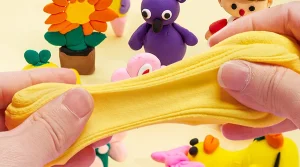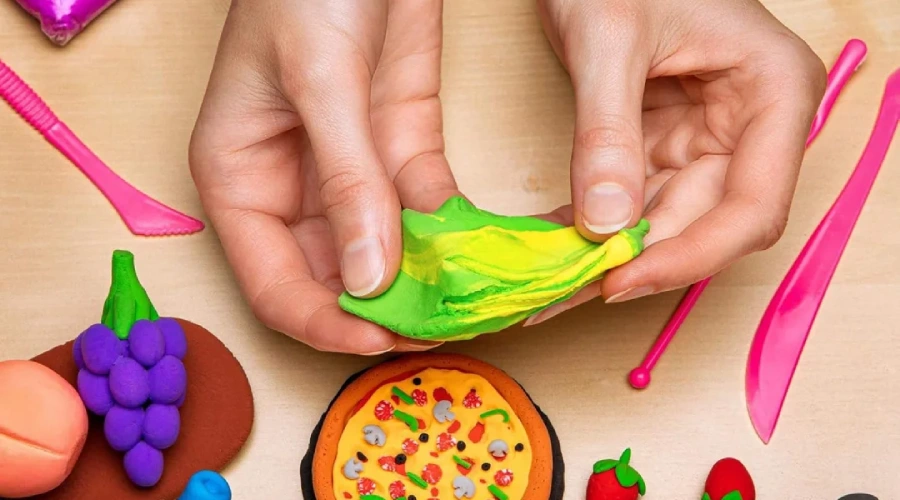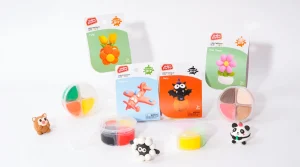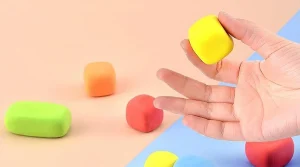
How to Use Lightweight Air Dry Clay?
Find out how to use lightweight air dry clay safely and creatively, from simple shapes to detailed crafts for children and beginners.
#1 Toys Manufacturer in China. WhatsApp: +86 180-0088-4063. Email: [email protected]
#1 Toys Manufacturer in China. WhatsApp: +86 180-0088-4063. Email: [email protected]

Modelling clay has been around for centuries, but the question of what it is made of still sparks curiosity. Some clays are dug from the ground, while others are mixed in labs. From natural minerals to synthetic polymers, the range is broad and each type follows its own recipe.
Many parents and teachers often ask what ingredients make up modeling clay, especially when kids use it in class. A science teacher once told me her students thought clay was just “dirt and water.” In fact, most clays are far more complex.
Curiosity also comes from safety concerns. Since children handle playdough or air dry clay often, people want to know how safe these materials are. Reports from the U.S. Consumer Product Safety Commission (CPSC, 2020) show that toy-grade clays must pass strict tests for chemicals.
Traditional modeling clay has roots in natural earth materials. Its recipe is simple but effective. Minerals, water, and binders work together to create a moldable substance that has been used for both art and practical objects since ancient times.
The backbone of classic clay is mineral-rich soil. Kaolinite, bentonite, and illite are some of the most common minerals found in clay bodies. These tiny particles are so small that they hold water and stick together, making the clay pliable.
When a child presses a lump of clay between their hands, they’re feeling the result of millions of microscopic platelets stacking and sliding. This fine-grained structure explains why natural clays are more workable than ordinary soil.
Water is the second key ingredient. It coats mineral particles, allowing them to slip over each other. This creates plasticity—the quality that lets clay hold its shape without breaking. Without enough water, the clay becomes crumbly and stiff.
Binders like organic matter or natural salts often appear in small amounts. These help the clay particles cling more firmly. In ancient times, potters would mix straw or ash into wet clay to add strength. Even today, ceramic clays sometimes contain additives for better performance.
Unlike natural clay, oil-based modeling clay does not dry out. It was designed for repeated use, making it popular in schools, studios, and even film animation. Its structure relies on a mix of oils, waxes, and fillers rather than minerals and water.
The main ingredients are soft waxes and mineral oils. These create a smooth texture and prevent moisture loss. Common fillers like talc or sulfur are added to control density and firmness. This balance makes the clay soft enough to shape yet firm enough to hold detail.
A child making figures from oil-based clay can reuse the same piece for weeks. The oils coat every particle, keeping the clay consistent no matter how often it is handled. Artists also value this stability when sculpting prototypes or models.
The absence of water explains why oil-based clay never hardens. Since its binder is oil, it cannot evaporate the way water does in natural clays. Without evaporation, there is no setting or curing process.
Instead, oil-based clays stay soft for years unless exposed to extreme heat. That property makes them ideal for stop-motion puppets or practice sculptures, where flexibility and reuse matter more than permanence.
>> Which Clay Is Best for Clay Modelling for Kids?
Polymer clay is different from natural or oil-based clays because it is not made from earth or minerals. Instead, it is a plastic-based modeling material. It stays soft until heated, when the ingredients react and turn solid. This makes it popular for jewelry, crafts, and small sculptures.
The main component of polymer clay is polyvinyl chloride (PVC). On its own, PVC is rigid, so plasticizers are mixed in to soften it. These small liquid molecules slide between PVC chains, giving the clay flexibility and allowing it to be kneaded like dough.
When baked at the right temperature, the plasticizers lock into the PVC structure. This causes the clay to harden permanently. Once cured, it no longer bends or reshapes, which is why crafters use it for detailed, lasting projects.
To create a wide range of appearances, pigments are blended into the base clay. These may be natural or synthetic colorants. Some clays also include mica powders or glitter to add shine, sparkle, or a pearlescent look.
Manufacturers sometimes add stabilizers to help prevent discoloration or brittleness. These additives make sure the final baked piece stays strong and keeps its color over time. In classrooms, this means kids can make bright, durable creations without the clay fading or breaking too easily.
Air dry clay is widely used in schools and craft sets because it does not require heat to cure. Unlike polymer or oil-based clays, it relies on a water-based formula that becomes solid as the water evaporates. This makes it safe and easy for kids and hobbyists.
A key ingredient in many air dry clays is polyvinyl alcohol (PVA). This water-soluble binder helps the clay particles stick together while still being pliable. It also reduces cracking during drying.
To keep the clay light and easy to mold, fillers such as microbeads, paper fiber, or starch are added. These fillers make the clay less dense than traditional earthen clays, so finished objects feel soft and lightweight.
Air dry clay does not need an oven because the water inside slowly escapes at room temperature. As the moisture leaves, the PVA binder holds the particles in place, forming a solid structure.
This process is called physical drying rather than chemical curing. It is slower than baking polymer clay but safer for children’s crafts, since no high heat is required. Once dry, the surface can be sanded or painted for extra detail.
Playdough stands apart from other modeling clays because it is soft, safe, and based on everyday kitchen ingredients. While not truly edible, its recipe often mirrors simple foods, making it non-toxic and friendly for young children.
>> How Many Types of Clay for Kids? A Fun and Complete Guide
Playdough is usually made from wheat flour as a base, giving it structure. Salt acts as a preservative and also prevents microbial growth. Water binds the mix together and creates its pliable texture.
Other additions may include cream of tartar for elasticity, food coloring for visual appeal, and small amounts of oil to prevent drying. This makes playdough soft and flexible but very different from clay mined from the earth.
Unlike modeling clay, playdough is not designed for permanence. It can dry out quickly, crumble, or grow mold if stored poorly. Traditional clays, whether oil-based or polymer, are made to last longer and often retain shape more effectively.
Playdough is best viewed as a toy and learning material, not a sculpting medium. Its purpose is more about sensory play, creativity, and safe handling, whereas modeling clays are often used for art, design, or prototyping.
When asking what is modelling clay made of, the next concern is safety. Not every clay is made for children. Some clays are safe for little hands, while others are designed for industrial or professional use and may contain chemicals that need careful handling.
Many kids’ clays, like playdough or air dry clay, are labeled non-toxic. They are tested so that accidental contact with skin or even tasting a small amount is not harmful. Ingredients like flour, PVA, or starch are common.
On the other hand, industrial clays can include solvents, synthetic resins, or heavy fillers. These help with durability or technical uses but are not safe for children. Reading labels and usage guides is essential to avoid confusion between toy-grade and industrial-grade clay.
Children’s modeling clays must meet safety standards, such as ASTM D-4236 in the U.S. or EN71 in Europe. These rules require testing for toxicity, heavy metals, and choking risks. Only clays that pass can be sold as toys.
This regulation framework ensures that parents and teachers can trust products labeled for kids. Without such rules, the line between safe play materials and hazardous art supplies would be unclear.
Clay ingredients not only affect performance and safety but also the planet. Some clays naturally break down in soil, while others use plastics that can linger for decades. Knowing the difference helps makers choose wisely.
Natural clays, such as earthen or mineral-based varieties, are biodegradable. Once discarded, they slowly return to the ground without leaving toxic traces. Even air dry clay with plant-based fillers tends to have a smaller footprint, though binders may alter the rate of decay.
Playdough, made from flour and salt, is also biodegradable. Its kitchen-based formula allows it to decompose much like food waste, though preservatives can delay this process a little.
Polymer clay is very different. It contains PVC and plasticizers, which are forms of synthetic polymers. These do not break down easily in nature and may persist in landfills for decades.
Some additives in polymer clay can also release microplastics during sanding or disposal. This makes it less eco-friendly than natural or flour-based clays. For long-lasting art, it works well, but it raises questions about sustainability.
Modeling clay behaves differently depending on its ingredients. Understanding its science explains why some clays stay soft, others harden, and why some can be reshaped endlessly.
Plasticity is the key property that allows clay to be molded. In natural clay, fine mineral particles slide over each other when pressure is applied, but stick together enough to hold shape.
Oil-based clays rely on waxes and oils to create a similar effect. The oil coats particles, giving flexibility and preventing drying. Polymer clay’s PVC chains, combined with plasticizers, slide past each other until heat locks them into place.
Water in natural and air dry clays acts as a lubricant, letting particles move freely. As it evaporates, the clay hardens. Oils in plastiline prevent drying and maintain softness indefinitely.
Polymers, like PVA or PVC, form long chains that give structure. In polymer clay, heat causes these chains to lock, creating permanent rigidity. Each ingredient affects how the clay responds to handling, shaping, and finishing.
Not all clays are created equal. Comparing modeling clay to other craft materials like air dry clay and playdough highlights differences in composition, usability, and purpose. Understanding these distinctions helps both parents and artists choose the right medium.
Modeling clay, especially oil-based or polymer types, is designed for repeated use and long-term projects. It maintains shape, can hold fine details, and may require heat to cure (polymer clay) or stay soft indefinitely (oil-based).
Air dry clay, by contrast, hardens naturally as water evaporates. It is lighter, less durable, and primarily used for crafts that don’t require repeated reshaping. Unlike modeling clay, air dry clay cannot be reworked once fully dried.
>> Is Modeling Clay Safe for Kids?
Playdough is more like a sensory toy than a sculpting material. It is soft, non-toxic, and easy to clean, but it dries quickly and cannot hold intricate shapes for long periods.
Modeling clay allows for precision, detail, and permanence. While both are safe for children, playdough emphasizes play and creativity, whereas modeling clay supports artistic work, design prototypes, and more professional crafting purposes.
Clay has been used by humans for thousands of years. From early pottery to modern synthetic formulations, the evolution of clay reflects both cultural creativity and technological progress.
Ancient civilizations relied on natural clays for pottery, sculpture, and building materials. Kaolin, bentonite, and other mineral-rich clays were shaped, dried, and sometimes fired in kilns to create durable items.
In Mesopotamia, children also played with clay figurines, hinting at early educational and creative uses. These practices demonstrate that clay has long served both practical and imaginative purposes.
Today, synthetic clays like polymer and PVA-based air dry clay expand the possibilities of modeling. Scientists and artists blend polymers, plasticizers, and pigments to create clays that can mimic natural textures, remain flexible, or harden permanently.
These innovations make clay safer for children, more versatile for artists, and consistent for industrial applications. Modern clay bridges centuries of tradition with contemporary material science.
Understanding what modelling clay is made of reveals the science behind its texture, flexibility, and safety. From natural minerals to PVA-based air dry clay and playdough, each type has a distinct formula and purpose.
Not all modeling clay is safe for kids. Non-toxic varieties like playdough or PVA-based air dry clay are tested for safety, while industrial or polymer clays may contain chemicals unsuitable for children.
Some types, like air dry clay, harden as water evaporates. Oil-based clay stays soft indefinitely, and polymer clay requires heat to set permanently. Each formula behaves differently due to its ingredients.
Polymer clay contains PVC and plasticizers, allowing it to stay soft until baked. Traditional clay relies on water and minerals, making it pliable but either air-drying or requiring firing to harden.
Playdough is a safe, edible-like variant of modeling clay. It uses flour, salt, and water, emphasizing sensory play and creativity rather than permanence or fine sculpting.
Air dry clay contains water and fillers. As the moisture evaporates, the clay particles pull together slightly. PVA and other binders reduce cracking, but some minor shrinkage is normal.
More Related...

Find out how to use lightweight air dry clay safely and creatively, from simple shapes to detailed crafts for children and beginners.

Montessori vs. normal toys: explore how design, purpose, and learning goals shape children’s play and development in meaningful ways.

Explore the truth about air dry clay and water—why it softens, what to avoid, and how to care for your crafts.

Wondering which clay is best for clay modelling for kids? Explore air dry clay, playdough, and more in this simple educational guide.

Our team will answer your inquiries within 48 hours.
Copyright © 2025 GuangDong AKIA Technology Co,. Ltd. All Rights Reserved